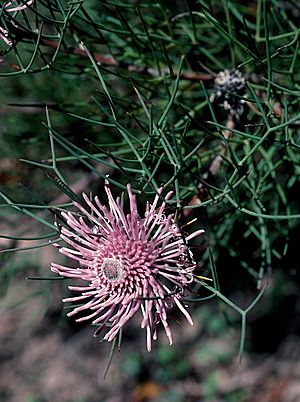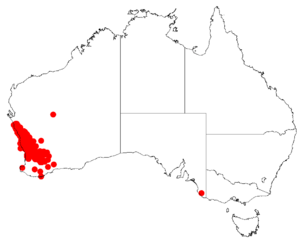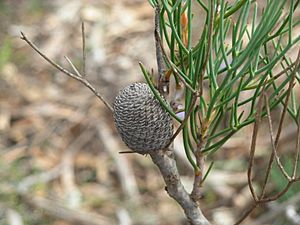Spreading coneflower facts for kids
Quick facts for kids Spreading coneflower |
|
|---|---|
 |
|
| Isopogon divergens in the ANBG | |
| Scientific classification | |
| Genus: |
Isopogon
|
| Species: |
divergens
|
 |
|
| Occurrence data from Australasian Virtual Herbarium | |
| Synonyms | |
|
Atylus divergens (R.Br.) Kuntze |
|

The Isopogon divergens, also known as the spreading coneflower, is a special plant. It belongs to the Proteaceae family, which includes many unique Australian plants. This shrub is found only in the south-west part of Western Australia.
It has interesting leaves that look like feathers. Its pink flowers grow in round shapes. After the flowers, it forms an oval or cylinder-shaped fruit called a fruiting cone.
Contents
What the Spreading Coneflower Looks Like
The spreading coneflower is a shrub that usually grows between 0.3 and 2 meters (about 1 to 6.5 feet) tall. It has reddish-brown branches.
Its leaves are long, from 50 to 150 millimeters (about 2 to 6 inches). They grow on a stalk up to 56 millimeters (about 2.2 inches) long. The leaves are divided into smaller parts, like a feather. These smaller parts are round and about 1 to 1.5 millimeters wide.
The flowers grow in round, oval, or oblong clusters. These clusters are about 40 to 45 millimeters (about 1.5 to 1.8 inches) wide. At the bottom of each flower cluster are special leaf-like parts called involucral bracts.
Each flower is about 15 to 25 millimeters (about 0.6 to 1 inch) long. They are pink, sometimes with a purple tint, and feel smooth. The plant blooms from August to October. After flowering, it produces a hairy, oval-shaped fruit called a nut. These nuts are joined together in a round cone, which is about 15 to 25 millimeters long.
How the Spreading Coneflower Got Its Name
The spreading coneflower was first officially described in 1830. A famous botanist named Robert Brown gave it its scientific name. He wrote about it in his book, Supplementum.
The plants he studied were collected in 1827. They were found near the Swan River by another botanist, Charles Fraser.
Where the Spreading Coneflower Lives
The spreading coneflower grows in areas with shrubs and open land called heath. It is found across a wide area in the south-west of Western Australia. You can see it between the Murchison River and Lake Grace.
It lives in several different natural areas. These include the Avon Wheatbelt, Geraldton Sandplains, Jarrah Forest, Mallee, and Swan Coastal Plain.
Is the Spreading Coneflower Safe?
The Government of Western Australia's Department of Parks and Wildlife says that the Isopogon divergens is "not threatened." This means it is not currently in danger of disappearing.

